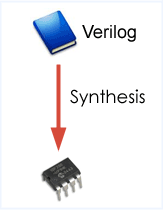
Synthesis is a broad term often used to describe very different tools. Synthesis can include silicon compilers and function generators used by ASIC vendors to produce regular RAM and ROM type structures. Synthesis in the context of this tutorial refers to generating random logic structures from Verilog descriptions. This is best suited to gate arrays and programmable devices such FPGAs.
Synthesis is not a panacea! It is vital to tackle High Level Design using Verilog with realistic expectations of synthesis.
The definition of Verilog for simulation is cast in stone and enshrined in the Language Reference Manual. Other tools which use Verilog, such as synthesis, will make their own interpretation of the Verilog language. There is an IEEE standard for Verilog synthesis (IEEE Std. 1364.1-2002) but no vendor adheres strictly to it.
It is not sufficient that the Verilog is functionally correct; it must be written in such a way that it directs the synthesis tool to generate good hardware, and moreover, the Verilog must be matched to the idiosyncrasies of the particular synthesis tool being used. We will tackle some of these idiosyncracies in this Verilog tutorial.
There are currently three kinds of synthesis:
- behavioural synthesis
- high-level synthesis
- RTL synthesis
There is some overlap between these three synthesis domains. We will concentrate on RTL synthesis, which is by far the most common. The essence of RTL code is that operations described in Verilog are tied to particular clock cycles. The synthesised netlist exhibits the same clock-by-clock cycle behaviour, allowing the RTL testbench to be easily re-used for gate-level simulation.


